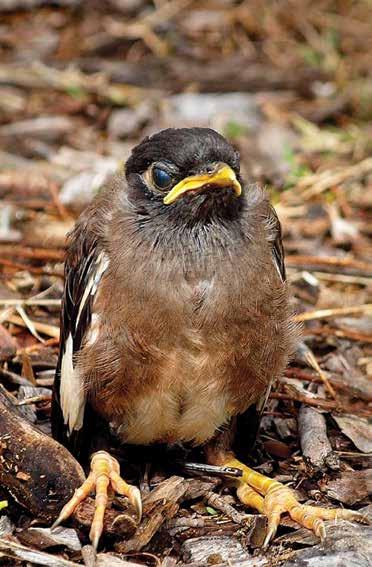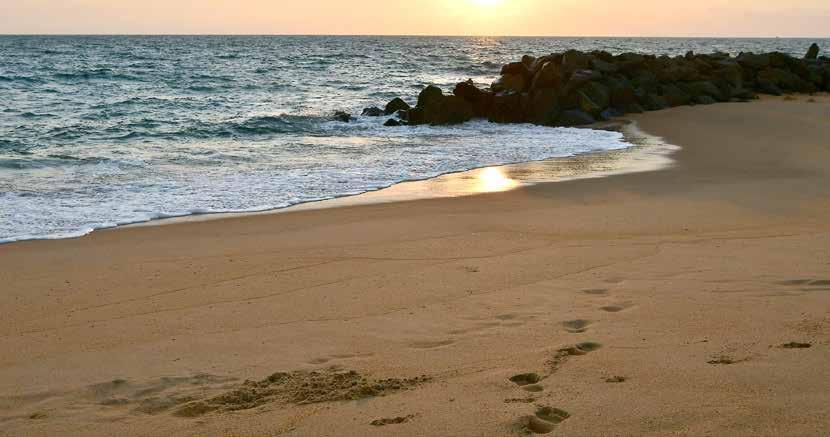
6 minute read
Nature Page
Common (Indian) Myna
Acridotheres tristis
Advertisement
By: Marj Webber
Common Mynas (Mynahs) are a bold and noisy pest species that has arrived on Bribie Island within the past 30 years and numbers are increasing. They are medium-sized birds 23-25 cm in length and weighing 120-140g. They have brown bodies, black heads, yellow bills and legs. Large white patches are revealed on the wings when in flight. Their strutting walk is accompanied by intermittent hops. Lifespan is usually about 4 years. Their bullying behaviour and their habit of overpowering and ejecting other birds from nest sites have aided them to multiply with success. They are usually seen in pairs or small to large flocks. Noisy night roosts are in trees or man-made structures. In Australia, they occupy most urban and some rural towns and farms along the east and south-east coasts and a short distance west of the Great Dividing Range. Warm to hot climates are their preference but they are also found in cold areas. In 1862 they were introduced from India to Melbourne to eradicate insects in market gardens. There were other introductions to Melbourne up until the 1950s. The plan was not successful, but the Mynas began to thrive and spread. North Queensland introduced them as predators for grasshoppers and cane beetles in the 1800s with similar disastrous consequences. They thrive in areas where the natural environment has been greatly disturbed such as towns and cities and are rarely seen in pristine habitats. India, Asia and the Middle East are their native homes. Common Mynas are omnivorous scavengers (flying rats) and will eat almost anything including pet food, insects, fruit and the young of other birds. Feeding takes place on the ground. They vigorously challenge other birds and native animals for their food supply. Farmers find them a pest in their orchards and market gardens. IUCN has named them as in the top 100 of the world’s most invasive pests. Breeding takes place mostly from Oct-March. They compete aggressively with other birds taking over their tree hollows and often evicting residents, destroying eggs and killing the young which reduces their breeding outcome. Glider and possum hollows are also a target for the Mynas. Untidy nests of grass, feathers and paper are constructed in cavities in buildings and can introduce mites and lice to the inhabitants. Four to six pale blue eggs are laid, and 1-3 broods can be produced each year. Moreton Bay Council’s approach to the problem is to enhance the natural environment, by habitat plantings. The council does not support a trapping program. Throughout Australia, many councils have Common Myna management plans and in some areas, there are citizen-led control programs to help reduce the increasing numbers. This is an ongoing battle.


An innovative partnership between the Queensland Government and the private sector will see tree logs salvaged from a significant Bruce Highway upgrade project find a new home on the banks of the Caboolture River. The trees have been salvaged from the Bruce Highway Upgrade Caboolture-Bribie Island Road to Steve Irwin Way (Exit 163) project, which is being jointly funded by the Australian and Queensland governments. The Australian Government has committed $530 million and the Queensland Government is contributing $132.5 million. The first major construction contract is being delivered by ACCIONA Construction Australia Pty Ltd (ACCIONA) for the Queensland Department of Transport and Main Roads (TMR).
An opportunity was identified by TMR to cut trees cleared ahead of construction into logs and offer them to Unitywater as part of the Caboolture River Nutrient Offset Project. This includes earthworks to stabilise the existing riverbank which is collapsing in places. A flat section of bank where mangroves can grow, known as a tidal bench, will be created and pinned logs will be placed along the bottom of the riverbank to protect it from boat wash. The riverbank is also being revegetated. Unitywater Executive Manager Sustainable Infrastructure Solutions Amanda Creevey said this stage of the Caboolture River Nutrient Offset Project will stop approximately 1.6 tonnes of nitrogen and phosphorus from entering the waterway each year. This presents an important opportunity for the utility to offset nutrient discharge associated with its Burpengary East Sewage Treatment Plant. “The project is a positive way for us to give back to the environment and help improve the Caboolture River for all of its inhabitants and our community who also come to enjoy it,” Ms Creevey said. “The tree logs provided by ACCIONA will serve an important part of this project and be used to help stabilise the riverbank and protect it from boat wash, allowing vegetation to naturally establish. “We’re proud to partner with the Department of Transport and Main Roads and ACCIONA to deliver this initiative and set a strong example when it comes to sustainable solutions across each of our sectors.”
ACCIONA’s Executive Regional Manager: Northern, Glenn McIlroy, said partnering with Unitywater on this local environmental initiative aligned well with ACCIONA’s vision to be a global leader and provider of sustainable solutions in transport infrastructure. “ACCIONA’s core vision is to meet the challenge of achieving sustainable development in all our business areas, so that the generations of today and the future will have a better life,” Mr McIlroy said. “Environmental partnerships, such as this vegetation repurposing project with Unitywater, are just part of how ACCIONA does business. We are always looking for ways to work sustainably, improve the environment and benefit local stakeholders in the areas we have a presence.” The Bruce Highway Upgrade - CabooltureBribie Island Road to Steve Irwin Way (Exit 163) project will widen an 11km section of the Bruce Highway from four to six lanes –improving safety and flood immunity and increasing traffic flows and capacity. The project is being delivered as two separate contracts. ACCIONA is delivering Contract 1 between Caboolture-Bribie Island Road and Pumicestone Road from late 2020 until early 2023. Contract 2, which is scheduled to start in mid-2021, will deliver the section between Pumicestone Road and Steve Irwin Way (Exit 163). ACCIONA is one of Australia and New Zealand’s preeminent construction companies with a unique mix of global expertise and deep local roots. It operates under strong local management with a highly capable domestic workforce and a
thorough understanding of the Australian market, and in partnership with top local businesses in New Zealand. ACCIONA is also a global leader in sustainable solutions for infrastructure, renewable energy and water treatment projects. In 2021, ACCIONA’s energy division will start construction on its largest ever wind farm in Australia, the MacIntyre complex in Queensland, with a total capacity of 1,026MW. Unitywater has been providing essential services to the Moreton Bay, Noosa and Sunshine Coast regions of South East Queensland for 10 years. Twenty-four hours a day, seven days a week, we provide our customers with a high-quality, safe and reliable water supply and sewerage services that are environmentally sustainable. We are committed to keeping our communities healthy – we live here too.
TREE LOGS FROM HIGHWAY PROJECT PUT TO GOOD USE

EXPERTS IN DESIGNING A BETTER PLANET





